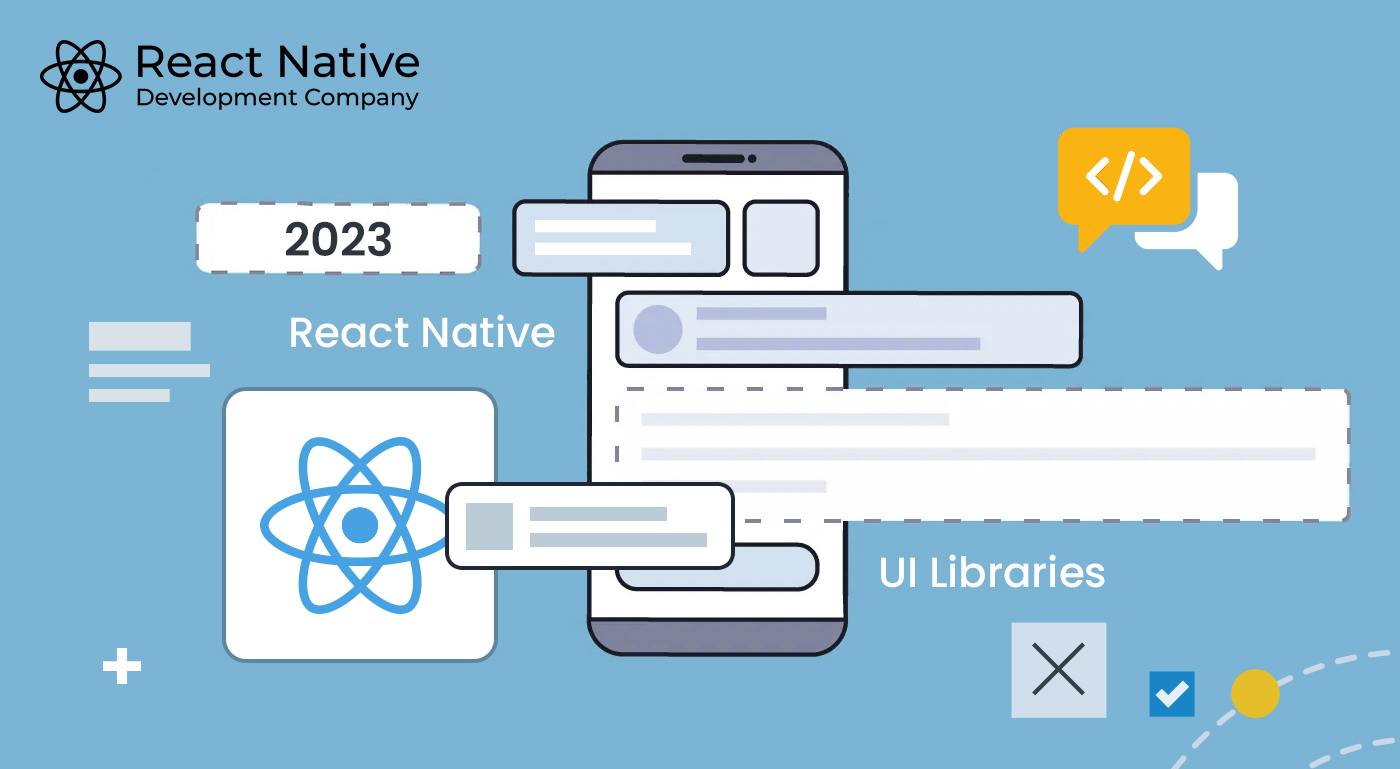
Top React Native UI Libraries 2023: Enhance App Design
In the swiftly changing arena of mobile app development, React Native has risen as a revolutionary contender. With its ability to create cross-platform applications using a single codebase, developers have flocked to this framework to streamline their development process. A pivotal aspect of any successful mobile app is its user interface (UI), and that’s where React Native UI libraries come into play. In this article, we’ll delve into the realm of React Native UI libraries, exploring their significance, and highlighting some of the best options available in 2023.
Table of Contents
- Introduction to React Native UI Libraries
- The Evolution of React Native UI Libraries
- Benefits of Utilizing React Native UI Libraries
- Exploring the Top React Native UI Libraries in 2023
- A Glimpse at React Bootstrap
- The Power of React Native Elements
- Building Aesthetic UIs with Shoutem
- Unleashing Creativity with NativeBase
- The Versatility of Ant Design for React Native
- Factors to Consider When Choosing a React Native UI Library
- Customization Options
- Community Support and Documentation
- Performance and Optimized Rendering
- Integration with Third-Party Libraries
- Best Practices for Implementing React Native UI Libraries
- Keeping Consistency in Design
- Prioritizing User Experience (UX)
- Responsive Design for Diverse Devices
- Accessibility: Reaching All Users
- The Future of React Native UI Libraries: Trends to Watch
- Conclusion: Elevate Your App’s Aesthetics and Functionality with React Native UI Libraries
Introduction to React Native UI Libraries
In the ever-evolving landscape of mobile application development, creating visually appealing and highly functional user interfaces is crucial to captivate users and drive engagement. This is where React Native UI libraries step in. These frameworks provide a selection of pre-built UI elements and components that can be seamlessly incorporated into your React Native app. By leveraging these libraries, developers can significantly expedite the UI development process, ensure a consistent design language, and ultimately provide an enhanced user experience.
The Evolution of React Native UI Libraries
Over the years, React Native UI libraries have evolved from simple collections of basic components to comprehensive frameworks that empower developers to craft intricate and sophisticated UIs. The journey began with the need for reusable components, such as buttons and input fields. As React Native gained traction, the demand for more advanced components grew, leading to the development of full-fledged UI libraries like React Bootstrap, React Native Elements, Shoutem, and more.
Benefits of Utilizing React Native UI Libraries
Integrating a React Native UI library into your project comes with a multitude of advantages. Firstly, it drastically reduces the time and effort required to build UI components from scratch. This accelerates the development cycle and allows developers to focus on refining the app’s functionality. Secondly, these libraries often follow design best practices, ensuring a consistent and visually pleasing interface across different screens and devices.
Furthermore, React Native UI libraries provide a level of customization that caters to various design preferences. Developers can easily tweak the appearance of components to align with the app’s branding and theme. This versatility strikes a balance between efficiency and uniqueness, enabling developers to create visually distinct applications without compromising development speed.
Exploring the Top React Native UI Libraries in 2023
A Glimpse at React Bootstrap
React Bootstrap, as the name suggests, combines the power of React with the popular Bootstrap framework. This fusion results in a robust set of UI components that are not only visually appealing but also highly functional. With a focus on responsive design and mobile-first approach, React Bootstrap empowers developers to create seamless user experiences across various devices.
The Power of React Native Elements
React Native Elements stands out for its extensive catalog of customizable UI components. From buttons and icons to navigation bars and form elements, this library covers it all. What sets React Native Elements apart is its ease of integration and intuitive customization options, making it an ideal choice for both beginners and experienced developers.
Building Aesthetic UIs with Shoutem
Shoutem takes a creative approach to UI design by offering a plethora of beautifully designed UI components. Whether you’re aiming for a sleek and modern look or a vibrant and playful interface, Shoutem provides the building blocks to bring your vision to life. Its drag-and-drop UI builder simplifies the design process even further, making it a favored choice among designers and developers alike.
Unleashing Creativity with NativeBase
NativeBase caters to developers who prioritize customization and creativity. With an extensive collection of theme-based components, developers can craft unique and visually stunning interfaces. The library’s theming capabilities allow for effortless design changes, ensuring that your app remains fresh and appealing to users.
The Versatility of Ant Design for React Native
Ant Design has gained widespread recognition for its comprehensive design system and meticulously crafted components. While originally developed for web applications, Ant Design’s React Native integration offers a wide range of components that adhere to a unified design language. This library is particularly valuable for projects that demand a professional and polished UI.
Read also: How many types of navigation in react native
Factors to Consider When Choosing a React Native UI Library
Selecting the right React Native UI library for your project requires careful consideration of various factors. Here are several important factors to take into account:
Customization Options
The level of customization offered by a UI library can significantly impact the final look and feel of your app. Opt for a library that allows you to tailor components to match your app’s branding and design language.
Community Support and Documentation
A thriving community and comprehensive documentation are indicative of a well-maintained and user-friendly library. Ample community support ensures that you can seek assistance when facing challenges during development.
Performance and Optimized Rendering
Efficient rendering and optimal performance are crucial for delivering a smooth user experience. Prioritize libraries that implement performance optimizations to ensure quick and seamless interactions.
Integration with Third-Party Libraries
Modern app development often involves integrating third-party services and libraries. Choose a UI library that seamlessly integrates with other popular libraries to enhance your app’s functionality.
Best Practices for Implementing React Native UI Libraries
Keeping Consistency in Design
Maintaining a consistent design throughout your app fosters familiarity and usability. Stick to a cohesive color palette, typography, and layout to create a harmonious user experience.
Prioritizing User Experience (UX)
While aesthetics are important, prioritizing user experience ensures that your app is intuitive and user-friendly. Conduct usability testing to identify pain points and optimize the UI accordingly.
Responsive Design for Diverse Devices
With the plethora of devices available, it’s essential to ensure that your app looks and functions well on various screen sizes. Implement responsive design principles to accommodate different devices and orientations.
Accessibility: Reaching All Users
Make your app accessible to a wide range of users, including those with disabilities. Incorporate accessibility features such as screen reader support and adjustable font sizes.
The Future of React Native UI Libraries: Trends to Watch
As technology continues to advance, the landscape of React Native UI libraries is poised for further innovation.
In conclusion, the realm of React Native UI libraries offers a gateway to enhancing both the aesthetics and functionality of your mobile applications. These libraries, which have evolved from simple collections of basic components to comprehensive frameworks, play a pivotal role in shaping the user experience. By streamlining the UI development process and providing a wide array of pre-designed components, React Native UI libraries empower developers to create visually appealing, consistent, and user-friendly interfaces.
In this article, we delved into some of the top React Native UI libraries that have gained prominence in 2023. React Bootstrap stands as a fusion of React and Bootstrap, delivering a responsive and mobile-first approach. React Native Elements offers an extensive catalog of customizable components, while Shoutem brings creativity to the forefront with its beautifully designed elements and user-friendly drag-and-drop UI builder. NativeBase empowers developers with theming capabilities for unparalleled customization, and Ant Design for React Native provides a professional and polished design system.


